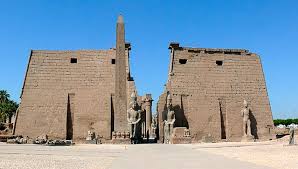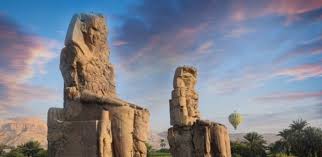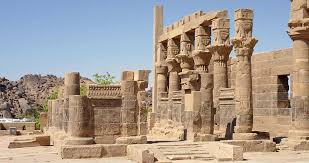

Tour To Luxor and Aswan for 4 days 2 days in Luxor 2 days in Aswan
AT FIRST
We Will Go To Luxor
The Temple of Luxor, known as Ipet Resyt in ancient times, is one of the most significant monuments of ancient Egypt. Located on the east bank of the Nile River in Luxor, it was dedicated to the Theban triad of Amun, Mut, and Khonsu. Built during the reign of Pharaoh Amenhotep III and later expanded by Ramses II, the temple is renowned for its impressive architecture, including grand columns, towering obelisks, and intricate carvings. It served as a major religious center and a site for annual festivals, playing a vital role in the spiritual life of ancient Egyptians. Today, the Temple of Luxor remains a key attraction, reflecting the grandeur and artistry of ancient Egyptian civilization.
Then we will move To
The new Rams Road
The Avenue of Sphinxes, recently restored and unveiled in Luxor, Egypt, is a remarkable archaeological project that reconnects the Karnak Temple to the Luxor Temple. Spanning approximately 3 kilometers, this ancient pathway is lined with hundreds of sphinxes, each symbolizing protection and power. Historically used for ceremonial processions, the avenue showcases the grandeur of ancient Egyptian architecture and offers visitors a unique opportunity to experience the rich cultural heritage of the region. The restoration efforts have not only revitalized this historical site but also enhanced Luxor’s status as a key destination for tourists interested in Egypt’s fascinating history.
And Then we will go To
Karnak Temple
The Karnak Temple, located near Luxor in Egypt, is one of the largest and most impressive religious complexes in the world
Karnak was primarily dedicated to the god Amun, his wife Mut, and their son Khonsu. The complex was a major religious center during the New Kingdom period (circa 1550–1070 BCE). The temple complex spans over 2 square kilometers and includes a variety of structures, such as temples, chapels, and obelisks. The Great Hypostyle Hall, with its 134 massive columns, is one of the most famous sections. The temple complex was the site of many important religious festivals, the most notable being the Opet Festival, which celebrated the fertility of the Nile and the annual flooding.
Visiting Karnak provides a fascinating glimpse into ancient Egyptian civilization and its religious practices.
And Then we will go To
Western Mainland Valley Of The Kings
The Valley of the Kings, located near Luxor, Egypt, is one of the most significant archaeological sites in the world. This burial ground, used from the 16th to the 11th century BCE, served as the final resting place for many pharaohs and powerful nobles of the New Kingdom. Hidden within the rugged cliffs, the valley contains over 60 tombs, including the famous tomb of Tutankhamun. Known for their intricate wall paintings and elaborate burial chambers, these tombs provide invaluable insights into ancient Egyptian beliefs and practices surrounding death and the afterlife. The Valley of the Kings remains a key attraction for visitors seeking to explore Egypt’s rich history and heritage.
And Then
Hatshepsut Temple
The Mortuary Temple of Hatshepsut, located near Luxor, Egypt, is one of the most impressive architectural achievement of ancient Egypt. Built during the 18th Dynasty for the female pharaoh Hatshepsut, it is renowned for its striking design and harmonious integration with the surrounding cliffs. The temple features three terraced levels adorned with colonnades, reliefs, and statues that celebrate Hatshepsut’s reign and divine lineage. As one of the few female pharaohs in ancient Egypt, her temple stands as a testament to her power and legacy. Today, it is a significant archaeological site and a popular destination for tourists interested in Egypt’s rich history
And Then
The Colossi of Memnon
The Colossi of Memnon, located near Luxor, Egypt, are two monumental statues that stand as guardians of the mortuary temple of Pharaoh Amenhotep III. Erected around 1400 BCE, these massive figures depict the pharaoh seated, each measuring about 18 meters (59 feet) in height. Originally part of a grand temple complex, the Colossi are famous for their impressive scale and craftsmanship. They are also known for their unique acoustic phenomenon, where the statues would produce haunting sounds at dawn, leading to myths and legends about their supposed ability to speak. Today, the Colossi of Memnon are a popular tourist attraction, offering a glimpse into the grandeur of ancient Egyptian art and architecture
And Then
Medinet Habu Temple
Medinet Habu, the mortuary temple of Pharaoh Ramesses III, is located near Luxor, Egypt. Constructed in the 12th century BCE, this temple complex is one of the best-preserved monuments of ancient Egypt. Renowned for its impressive architecture and intricate reliefs, Medinet Habu showcases scenes of military victories and religious rituals. The temple’s massive walls and impressive courtyards reflect the grandeur of Ramesses III’s reign. Additionally, the site features a unique blend of religious and funerary functions, making it an important cultural and historical landmark. Today, Medinet Habu is a fascinating destination for visitors eager to explore the rich heritage of ancient Egyptian civilization.
And Then My Dear Guest WE Will Continue Our Trip To Aswan
Lets Start With
Horus Temple
The Temple of Horus at Edfu, located near Aswan, Egypt, is one of the best-preserved ancient temples in the country. Dedicated to the falcon-headed god Horus, this temple was constructed during the Ptolemaic period, around 237–57 BCE. Renowned for its stunning architecture and intricate hieroglyphic inscriptions, the temple features a massive entrance and a beautifully decorated interior, including a sanctuary where rituals were performed. The Temple of Horus serves as a vital site for understanding ancient Egyptian religion and mythology, particularly the worship of Horus as the god of the sky and protector of the pharaohs. Today, it remains a significant tourist attraction, drawing visitors to experience its historical and cultural richness.
And Then My Dear Guest WE Will Go TO
Kom Ombo
The Temple of Kom Ombo, located near Aswan, Egypt, is a unique ancient temple dedicated to two deities: Sobek, the crocodile god, and Horus, the falcon-headed god. Built during the Ptolemaic period around 180–47 BCE, this temple is notable for its symmetrical design, featuring two identical entrances, halls, and sanctuaries for each deity. The temple complex is renowned for its beautifully preserved reliefs, including depictions of surgical instruments, which highlight the advanced medical practices of ancient Egyptians. Set against the scenic backdrop of the Nile, Kom Ombo offers visitors a fascinating glimpse into the religious and cultural practices of ancient Egypt, making it a significant archaeological site
And Then My Dear You Will Visit
The High Dam
The Aswan High Dam, completed in 1970, is one of Egypt’s most significant engineering achievements. Located on the Nile River near Aswan, the dam was constructed to control flooding, generate hydroelectric power, and provide irrigation for agriculture in the surrounding regions. Spanning over 3,800 meters (12,500 feet) in length and rising 111 meters (364 feet) high, the dam creates Lake Nasser, one of the largest artificial lakes in the world. The Aswan High Dam has played a crucial role in transforming Egypt’s economy, enabling increased agricultural production and providing a reliable source of electricity. Today, it stands as a symbol of modern engineering and development in Egypt
And Then My Dear We Will GO To
Nasser Lake
located near Aswan, Egypt, is one of the largest artificial lakes in the world, formed by the construction of the Aswan High Dam in the 1960s. Stretching approximately 500 kilometers (310 miles) in length, the lake plays a crucial role in regulating the flow of the Nile River, providing essential water for irrigation and hydroelectric power generation. Named after President Gamal Abdel Nasser, the lake is also a vital resource for local fisheries and tourism. The surrounding area is rich in archaeological sites, some of which were relocated to higher ground to protect them from flooding. Lake Nasser is not only a significant engineering achievement but also a key element in Egypt’s agricultural and energy sectors
And Finally My Dear We Will Head To
Philae Temple
The Temple of Philae, located on Agilkia Island near Aswan, Egypt, is a stunning ancient temple complex dedicated to the goddess Isis. Originally situated on Philae Island, the temple was relocated to its current location during the construction of the Aswan High Dam to prevent flooding. Dating back to the Ptolemaic period, around the 4th century BCE, the temple is known for its beautiful architecture, intricate carvings, and serene setting by the Nile. Philae played a significant role in the worship of Isis and was an important pilgrimage site in ancient Egypt. Today, it is a popular tourist destination, attracting visitors with its historical significance and breathtaking views
















لا تعليق